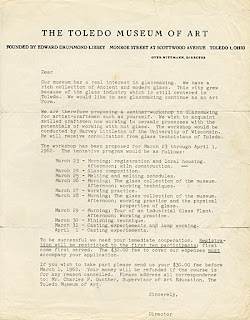>
During the 1950s, studio ceramics and other craft media in the U.S. began to gain in popularity and importance, and artists interested in glass looked for new paths outside industry sources. At that time, access to glass was only through industrial production. Students were not taught hands-on techniques with the material; the craft of working with hot glass was still taught at the factories, under the apprenticeship system. The catalyst for the development of studio glass was Harvey Littleton, a teaching ceramist at the University of Wisconsin in Madison.
Informed by his own background in the material (he grew up in the shadow of Corning Glassworks, where his father headed Research and Development during the 1930’s), Harvey started experimenting with hot glass in his studio in 1958. He eventually realized that his desire to develop studio glassblowing could become a reality after experiencing limited success with his own glassblowing experiments.
The 1962 Toledo Workshop program
Harvey joined forces with the Toledo Museum of Art, the site of the “birth” of the American Studio Glass movement during two historic glassblowing workshops in 1962. He worked with glass research scientist Dominick Labino, who successfully devised a small, inexpensive furnace in which glass could be melted and worked, making it affordable and possible for the first time for artists to blow glass in independent studios.
Harvey Littleton subsequently started a glass program at the University of Wisconsin in Madison, and some of his early students were Dale Chihuly, Marvin Lipofsky, and Fritz Dreisbach, all artists who have played seminal roles in raising the awareness of studio glass around the world.Source: CMOG
As GlassWeekend 2011 gets started, The Washington Glass School Blog visited with Harvey’s daughter Maurine Littleton at her art gallery in Washington, DC, as she prepared for the exhibition. Maurine brought out some of the early glass pieces made by Harvey at the workshops.
Maurine Littleton discusses the early Harvey Littleton pieces. In the background are Harvey Littleton works ca 1986.
Two Harvey Littleton vases from the 1962 Toledo workshop. The pieces are engraved on the bottom with Harvey’s name and date.
Harvey’s first pieces in blown glass were, like his earlier works in pottery, functional forms: vases, bowls and paperweights. His breakthrough to non-functional form came in 1963 when, with no purpose in mind, he remelted and finished a glass piece that he had earlier smashed in a fit of anger. The object lay in his studio for several weeks before he decided to grind the bottom. As Harvey recounts in his 1971 book Glassblowing: A Search for Form, he brought the object into the house where “it aroused such antipathy in my wife that I looked at it much more closely, finally deciding to send it to an exhibition. Its refusal there made me even more obstinate, and I took it to New York … I later showed it to the curators of design at the Museum of Modern Art. They, perhaps relating it to some other neo-Dada work in the museum, purchased it for the Design Collection.”
Harvey’s birthday is June 14th – he turns 89 this year. Everyone here at the Washington Glass School sends Harvey Best Wishes for a Happy Birthday!
The Smithsonian Institution has a fascinating oral history interview with Harvey – made in 2001. Click HERE to jump to the SI web-link.

